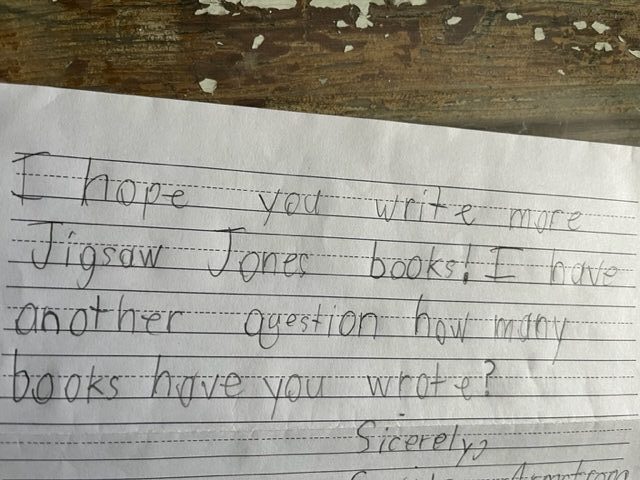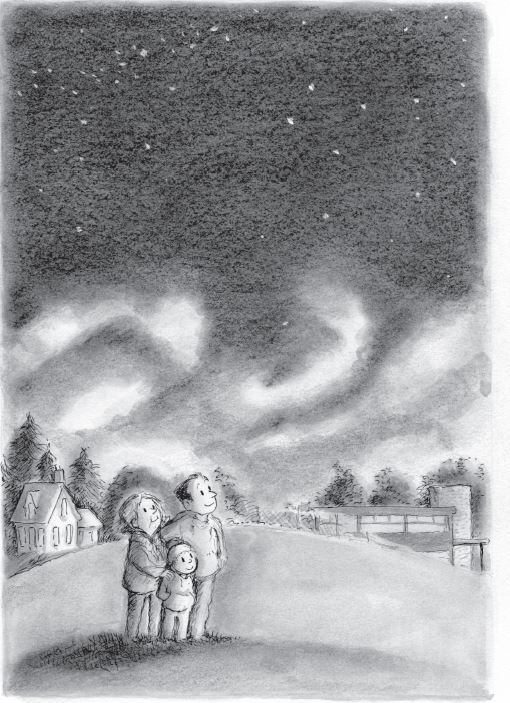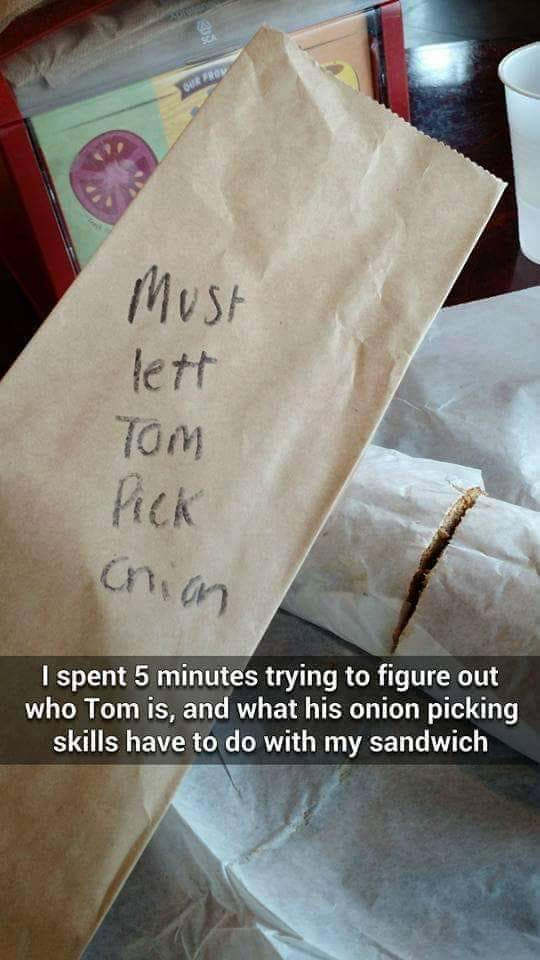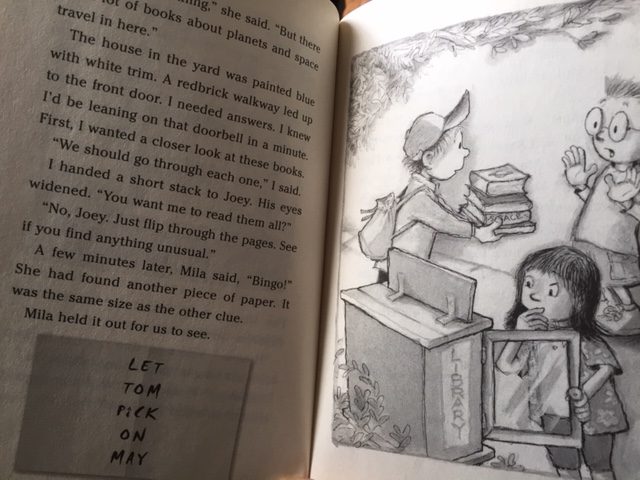–

–
I suppose it’s true of most authors, but it seems especially true of Robin Pulver. She’s a lot like her books: Funny, warm, inclusive, smart — and a little silly too. Today we talk about the latest in her “Language Arts Library” series, and William Steig, and Mrs. Toggle, and the hurt of going out of print, and more.
Robin, thanks for coming by. Normally I like to keep the “5 Questions” series focused on one title –- so we’ll spend time on Me First: Prefixes Lead the Way from your “Language Arts Library” series. But I also want to learn a little bit more about you in general. Sound good? I wonder: When did you first dream of becoming a writer?
I never dreamed of becoming a writer. In 8th grade, I had to write an autobiography. The story of my 13 years was LOOOOONG, because I liked to write. At the end, I was supposed to tell my ambition (i.e. dream?), so I said “art teacher,” because I loved art class. I still do love art, so now it seems miraculous to me that my love of writing somehow led to writing picture book stories that are illustrated by great artists. My being an author evolved from liking to write, studying journalism in grad school, then realizing my personality wasn’t right for the kind of investigative journalism I admire, writing a couple of newspaper columns, doing public relations for an insurance company, studying fiction writing for adults, selling some short stories, reading to my kids, loving the books, writing for children’s magazines, and then selling one of my intended magazine stories as a book: Mrs. Toggle’s Zipper!
–

–
That unlikely progression actually makes sense. There’s continuity to it. It’s like sailing. You don’t get there in a straight line. On your website, you tell a wonderful story about a day in your third-grade classroom.
Yes! A formative moment, when I look back. I had a third-grade teacher I adored. She was only 19. Miss Hamrick. One day she sent me to the back of the room to write a story. No regular school work! I wrote “The Flowers that Talked” and at the end of the day read it aloud to my classmates. (Never since have I been able to write a story in one day!) Maybe that was early prep for an author visit to a school.
Good old Miss Hamrick. God bless the teachers who recognize our strengths and say, “I believe in you.” Robin, I became a fan after your first book, Mrs. Toggle’s Zipper. She’s a kind, warm-hearted elementary school teacher who gets trapped inside her “big, puffy, fuchsia-colored” winter coat. The feeling of community in that school comes through loud and clear.
The story was inspired when my daughter’s zipper got stuck at school, and the nurse called me to say they were going to have to cut the coat off, so I should bring another coat for her to wear home that day. I wrote about a teacher’s coat because I thought kids would find that funnier. I used the word “fuschia,” because I liked the sound of it, not being sure what color that was! Recently, when I re-read “The Flowers that Talked,” (Mom saved it), the community of flowers reminded me of Mrs. Toggle’s classroom. Makes me wonder about my versatility! But I do have a basic belief that “it takes a village to raise a child,” and the school and classroom qualify as communities.
Mrs. Toggle is such a lovely character. And a great teacher. All four of the “Mrs. Toggle” books are warm, full of gentle wit and kindness, wonderfully illustrated by our mutual friend, R.W. Alley. I hope you are enormously proud of those books, they are an absolute triumph.
That is so nice of you to say. SO NICE.
It’s only the truth.
A teacher once told me that no teachers would like the Mrs. Toggle books. “They’re too sarcastic. The only smart person in them is the custodian. I decided you must be married to a custodian!” (I’m not. He’s an allergist.) He said that at one of my first school visits in a lunchroom full of guests! Funny, how those criticisms stay with a person, even though the book did so well. So, again, thank you!
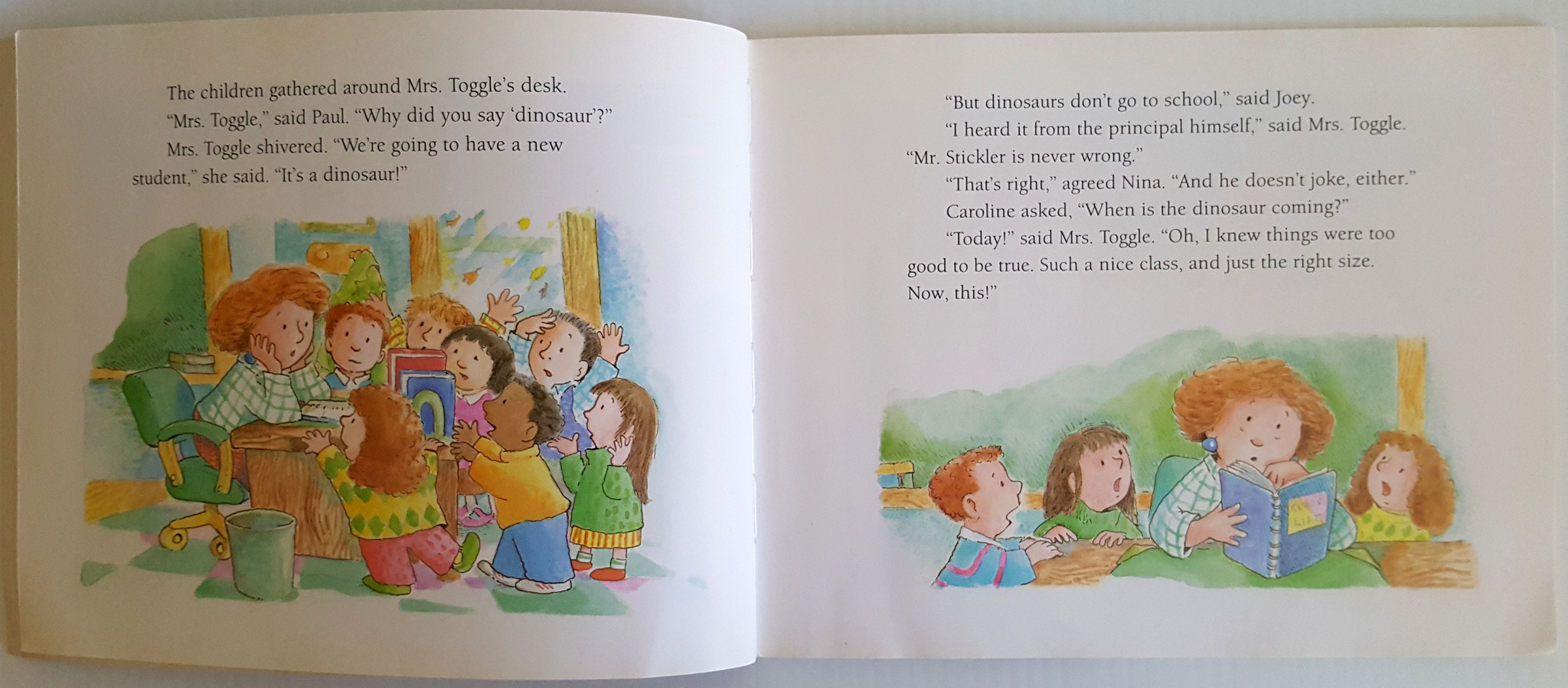
You experienced a professional writer’s full journey with that series. The books enjoyed great success –- well reviewed, embraced by classroom teachers, beloved by countless readers. And then, over time, you had the painful experience of watching them go out of print. I know how that feels. It’s not death, exactly, but there’s definitely a sense of loss.
It’s hard! At book festivals and signings, I hear, “Mrs. Toggle is my favorite!” (One teacher even told me that her daughter named her blanket “Mrs. Toggle.”) And yet, those books have long been out of print, and the original publisher exists no more. Bob Alley has indicated that he’d love to re-illustrate them in his updated style (which is wonderful! See Mrs. Toggle’s Class Picture Day and Saturday Is Dadurday). Wouldn’t it be nice to have a 30th anniversary edition of Mrs. Toggle’s Zipper? I know that a lot of adult teachers loved Mrs. Toggle when they were children. Now I’m whining. Sorry.
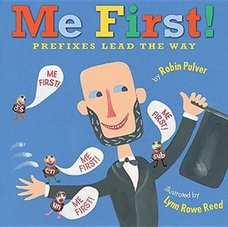
No need to apologize, I opened that door and I appreciate your honesty. We like to think of a book -– a good book -– as something that will endure. Not immortality perhaps, but something that lasts. It’s painful to learn that it’s not generally true except in the rarest of circumstances.
And the older I get, the more I realize that’s true. One of my favorites, Alicia’s Tutu, was out of print after 6 months.
Heartbreaking. I’ve been there. You look at your life’s work, your accomplishments, and poof. Like it never happened. Now it’s my turn to apologize for whining.
It’s confidence shaking and demoralizing, isn’t it, after so much trying, waiting, revising, finally getting a book accepted and waiting for it to come out. Then, as you say, poof!
Let’s shift gears. Rereading your “Mrs. Toggle” books, I was struck by the amount of story, the pure word count. Over the years, we’ve seen the picture book market get younger and younger. We don’t see many with a lot of words anymore. The emphasis has shifted decidedly to the pictures. Do you find that to be true in your experience?
Might this have to do with shortening attention spans in all ages? Including parents? But I’ve heard that there’s movement toward longer-text books again. I hope so. While I greatly admire authors who can write in such spare text, often way under 500 words, my natural word count seems to be 1000-1250 words. Hey, picture books are for all ages. Often these books use challenging vocabulary, and younger kids absorb that during read-alouds (an adult reading to a child inspires the child to learn to read herself). Older children — adults too — enjoy the story and the fine art in a good picture book.
I sometimes wonder what would happen to William Steig today? I mean, I’m sure he’d triumph in any era, but I wonder if the response from editors might be, “too many words.”
Oh, I love that you wonder that! William Steig was my first inspiration. Amos and Boris! The characters! The fantastic vocabulary! I bought that book for myself before I ever “dreamed” of writing books for children or had children of my own. (I learned from your pal, Matthew Cordell, that Amos and Boris was his early inspiration as well.)
Steig was amazing. He published his first children’s book at age 60. You got an earlier start. Then about 15 years ago, you hit upon an idea to write a story about punctuation, titled Punctuation Takes a Vacation. And now here we are here, celebrating the sixth title in the “Language Arts Library,” Me First. These books are about grammar, yes, but each one is playful, exuberant, and even a little wacky. How do you make a book about prefixes so lively and lighthearted? Where do you even begin?
–
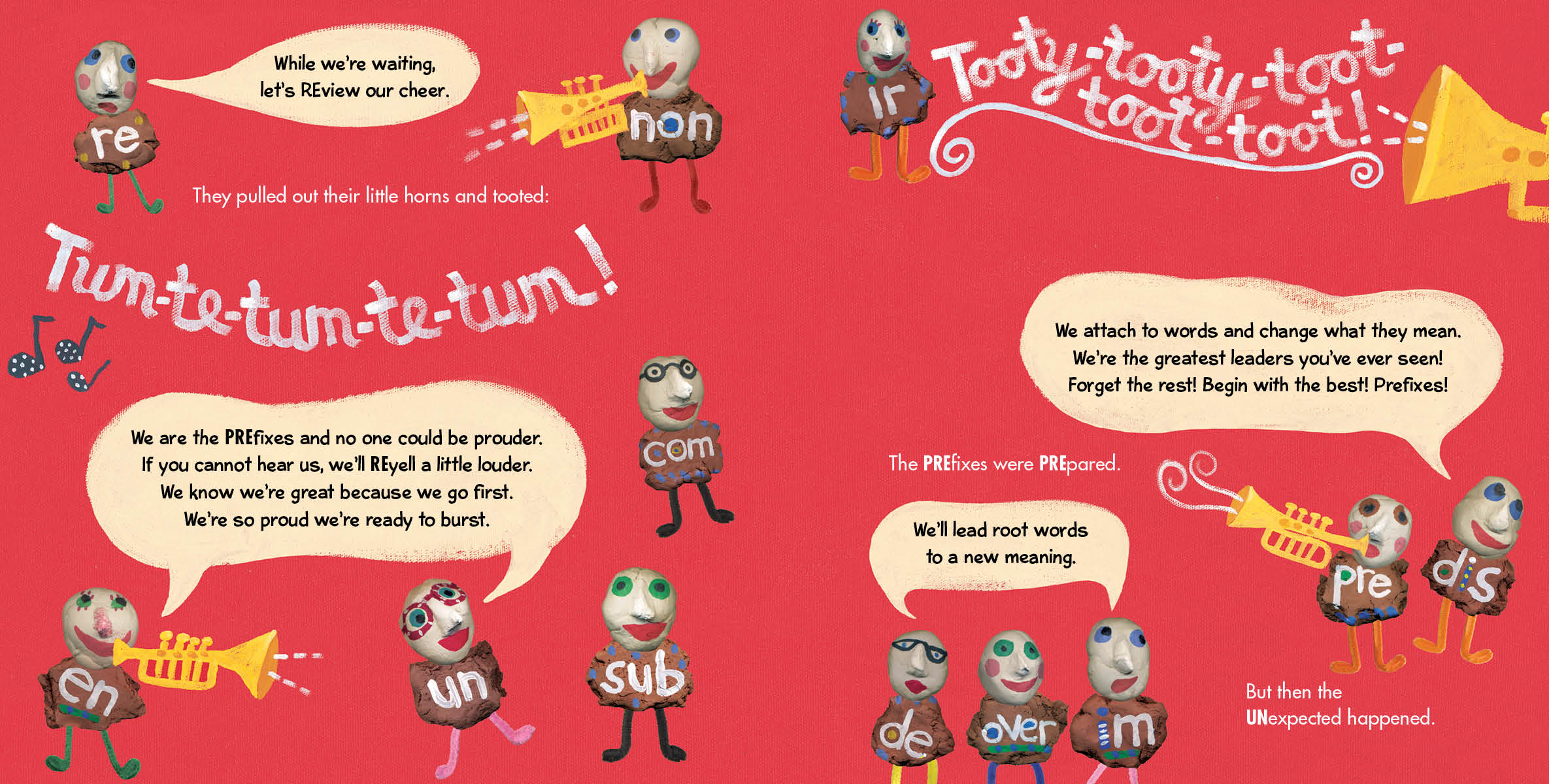
It took me three intense years to write Punctuation Takes a Vacation. A huge stack of attempts and fumbling approaches. (I persisted!) When I told my editor, she said, “It’s so light-hearted, I thought you wrote it in a day.” NO. They’ve all been a struggle for me.
Whenever an author talks about how a book “wrote itself,” I want to scream. My books don’t ever write themselves. I do all the work!
I keep at it because I love language and word usage. For Me First!, I did tons of research. Not only about prefixes, and what prefixes are taught at what level, and how they’re taught, but also about Abraham Lincoln, to find appropriate nuggets to use from his life. (I HAD to use the fact that he stored reminders to himself in his stovepipe hat.) When I learned that Leadership Day is observed in schools, I felt I’d found the connection to make between prefixes and the qualities that made Lincoln a great leader. Then I set out to write a story using lots of words with prefixes! I hope these books share my love of language with kids.

What’s your relationship with illustrator Lynn Rowe Reed? It must have evolved over the years. At what point is she brought into the process?
We have a strong on-line friendship, but I’ve only met her once, when we presented together at a conference. She waits ever so patiently (well, not really, she spurs me on!) for me to come up with a story and gets to work on it once it’s been revised and edited. Her illustrations are bold and lively and colorful. They’re the reason I’ve been told that toddlers love these books and carry them around! The first editor who rejected Punctuation Takes a Vacation said, ”Who on earth could illustrate this?” Luckily Lynn could.
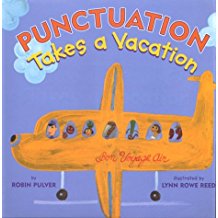
Yes, Lynn does a rather incredible job with those books. Her sense of playfulness is a big part of the overall appeal.
Which is another reason kids of all ages enjoy these books. They’re used in nursery schools and all the way through college.

I understand that you meet with a writer’s group. Tell us a little bit about that, why you like it, how it works, and so on.
The writers’ group I’m in now has lasted for 20 years, with some comings and goings. Shall I name names? Bruce Coville, Kathy Coville, Vivian Vande Velde, Ellen Stoll Walsh, MJ Auch, Patience Brewster, and Cynthia DeFelice. (We meet once a month, centrally at Cynthia’s home.) Our relationships are deep, supportive, and inspiring. We read from our work aloud and then critique (usually going around the room). I spend each meeting wondering how I got so lucky and privileged to hear their works in progress. There is all kinds of hilarity as well.
Thanks for coming over today, Robin. You just made a rough year a little kinder, a little softer. Keep up the great work!

Jigsaw flashes his business card. “Wowee zowee.” Maybe not as beautiful as the real Mrs. Pulver, but hopefully a fair approximation of her kindness and spirit.
It was fun to think about these kind and thoughtful questions. Thanks so much, Jimmy. I look forward to seeing you again and to reading your next books (including the one I have a special interest in, Jigsaw Jones: The Case from Outer Space).
Yes, I modeled a secondary character after you, the charming “Mrs. Pulver.” Jigsaw questions her as a witness in a case that concerns her Little Free Library. She’s lovely and kind, just like you, and I was glad to sneak that sly tribute into my book.
ROBIN PULVER is the author of many wonderful books including Thank You, Miss Doover; Axle Annie, and Saturday Is Dadurday, and many more.
Authors and illustrators previously interviewed in my “5 Questions” series include: Hudson Talbott, Hazel Mitchell, Susan Hood, Matthew McElligott, Jessica Olien, Nancy Castaldo, Aaron Becker, Matthew Cordell, Jeff Newman, Matt Phelan, Lizzy Rockwell, Jeff Mack, London Ladd, John Coy, Bruce Coville, Matt Faulkner, Susan Verde and Elizabeth Zunan. To find past interviews, click on the “5 Questions” link on the right sidebar, under CATEGORIES. Or use the “Search” function.
 (meaning: that you can buy them in stores or online). Of those, I’m especially fond of The Case of the Bicycle Bandit and The Case of the Buried Treasure. The most recent title is The Case of the Hat Burglar, which was inspired by the “Lost and Found” tables that I see on school visits. What if, I asked myself, someone was stealing items from the “Lost and Found”?
(meaning: that you can buy them in stores or online). Of those, I’m especially fond of The Case of the Bicycle Bandit and The Case of the Buried Treasure. The most recent title is The Case of the Hat Burglar, which was inspired by the “Lost and Found” tables that I see on school visits. What if, I asked myself, someone was stealing items from the “Lost and Found”?


